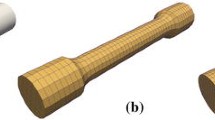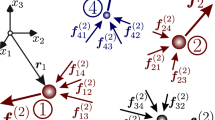Abstract
Numerical simulation has reached a point where it is on a par with laboratory experiment and mathematical theory as a tool for materials research. For example, molecular dynamics computations now can predict the motions of tens of millions of molecules in a solid that is undergoing deformation or fracture. The question is how to use such huge amounts of information to gain deeper understanding of the properties of real materials. I believe that it is an inefficient use of computational facilities to try to go directly from atomistic simulations to specific macroscopic phenomena. A better strategy is to use the simulations to identify dynamic variables that characterize the internal states of materials, and to use the equations of motion for these variables along with equations for stress and strain to predict macroscopic behavior. I shall illustrate this strategy by describing recent work by M. Falk and myself on plasticity in amorphous solids.
Similar content being viewed by others
References
Lubliner, J., Plasticity Theory, Macmillan Publishing Company, New York, NY, 1990.
Hill, R., The Mathematical Theory of Plasticity, Clarendon Press, Oxford, 1960.
Falk, M.L. and Langer, J.S., Phys. Rev. E, 57 (1998) 7192.
Ruina, A., J. Geophys. Res., 88 (1983) 10359.
Dieterich, J.H. and Kilgore, B.D., Pageoph., 143 (1994) 283.
Carlson, J.M. and Batista, A.A., Phys. Rev. E, 53 (1996) 4153.
Spaepen, F., Acta Metall., 25 (1977) 407.
Argon, A., Acta Metall., 27 (1979) 47.
Argon, A. and Kuo, H., Mater. Sci. Eng., 39 (1979) 101.
Spaepen, F. and Taub, A., In Physics of Defects, 1981 Les Houches Lectures, Session XXXV, North Holland, Amsterdam, 1981, p. 133.
Argon, A. and Shi, L., Acta Metall., 31 (1983) 499.
Cohen, M. and Turnbull, D., J. Chem. Phys., 31 (1959) 1164.
Turnbull, D. and Cohen, M., J. Chem. Phys., 34 (1961) 120.
Turnbull, D. and Cohen, M., J. Chem. Phys., 52 (1970) 3038.
Langer, J.S. and Lobkosvsky, A.E., Phys. Rev. E, 58 (1998) 1568.
Langer, J.S. and Lobkosvsky, A.E., Rate-and-State Theory of Plastic Deformation Near a Circular Hole, Phys. Rev. E, to be published.
Author information
Authors and Affiliations
Rights and permissions
About this article
Cite this article
Langer, J. Numerical and analytic routes from microscales to macroscales in theories of deformation and fracture. Journal of Computer-Aided Materials Design 6, 89–94 (1999). https://doi.org/10.1023/A:1008740120212
Issue Date:
DOI: https://doi.org/10.1023/A:1008740120212




